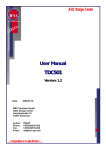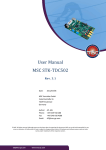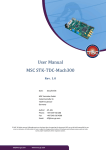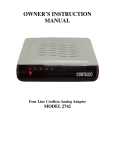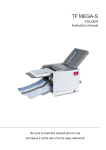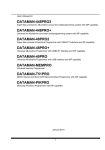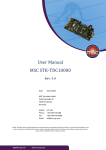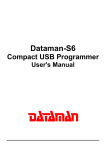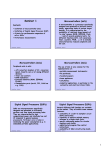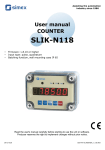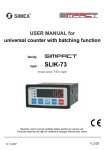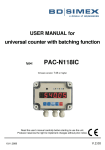Download User manual MSC TDC501, Rev. 1.4
Transcript
User Manual MSC TDC501 Version: 1.4 Date: 2010/01/13 MSC Vertriebs GmbH Industriestraße 16 76297 Stutensee Germany Author: Phone: Fax: Email: UW/AP +49 7249 910 205 +49 7249 910 268 [email protected] © MSC. All rights reserved. Although great care has been taken in preparing this document, MSC can not be held responsible for any errors or omissions. All information in here is subject to change without notice. All hardware and software names used are trade names and/or trademarks of the respective owners. [email protected] www.msc-ge.com User Manual - MSC TDC501 MSC Page 2 of 37 Contents 1 INTRODUCTION ...................................................................................................................... 4 2 OVERVIEW ............................................................................................................................... 5 2.1 FEATURES ............................................................................................................................. 5 2.2 GENERAL DESCRIPTION ........................................................................................................ 6 2.2.1 Time Difference Measurement ........................................................................................ 6 2.2.2 Temperature Measurement .............................................................................................. 7 2.2.3 Generating Calibration Values ......................................................................................... 7 2.2.4 Processor Interface ........................................................................................................... 7 2.3 BLOCK DIAGRAM .................................................................................................................. 8 3 FUNCTIONAL DESCRIPTION .............................................................................................. 9 3.1 INPUT UNIT ........................................................................................................................... 9 3.1.1 Auto Noise Unit ............................................................................................................... 9 3.2 TEMPERATURE MEASUREMENT UNIT ................................................................................. 11 3.3 MEASUREMENT UNIT .......................................................................................................... 13 3.3.1 Mode = 0 Function (Measurement Range 0) ................................................................. 13 3.3.2 Mode = 1 Function (Measurement Range 1) ................................................................. 14 3.3.3 Principle Function of the Fine Quantisation Unit .......................................................... 14 3.4 16-BIT CPU AND PROCESSOR INTERFACE........................................................................... 16 3.4.1 16-Bit CPU ..................................................................................................................... 16 3.4.2 Data Formats .................................................................................................................. 18 3.4.3 Processor Interface ......................................................................................................... 18 3.4.4 Instruction Set ................................................................................................................ 18 3.4.5 Writing the TDC ............................................................................................................ 19 3.4.5.1 Write MODE Register ........................................................................................... 19 3.4.5.2 Write TEMP Register............................................................................................. 20 3.4.5.3 Initialization Instruction INIT (HEX 00 or HEX 08) ............................................ 20 3.4.6 Reading the TDC ........................................................................................................... 22 3.4.6.1 Reading the Status Register ................................................................................... 22 3.4.6.2 Reading the Time Registers ................................................................................... 24 3.4.6.3 Reading the Original Data...................................................................................... 24 4 MEASURING FEATURES OF THE TDC501 ..................................................................... 26 4.1 MEASURING IN THE MEASUREMENT RANGE 0 ...................................................................... 26 4.2 MEASURING IN THE MEASUREMENT RANGE 1 ...................................................................... 26 4.2.1 Burst mode ..................................................................................................................... 27 4.2.2 Separate generation of calibration values without previous measurement .................... 27 4.3 TEMPERATURE MEASUREMENT ........................................................................................... 28 4.4 ADDITIONAL OPTIONS FOR ALL MODES ............................................................................... 29 TDC501RefManEngV14.doc [email protected] Version: 1.4 www.msc-ge.com Author: UW/AP User Manual - MSC TDC501 MSC Page 3 of 37 5 TYPICAL INSTRUCTION SEQUENCES AND TIMING DIAGRAMS .......................... 30 6 APPENDIX ............................................................................................................................... 32 6.1 ELECTRICAL SPECIFICATIONS ............................................................................................. 32 6.1.1 Recommended Operating Conditions ............................................................................ 32 6.1.2 Absolute Maximum Ratings .......................................................................................... 32 6.2 CURRENT CONSUMPTION ..................................................................................................... 33 6.3 PACKAGE AND PIN CONFIGURATION ................................................................................... 34 6.4 APPLICATION EXAMPLES USING 4/8-BIT PROCESSORS ........................................................ 36 6.4.1 TDC501 with 4-Bit Interface ( with µPD753xx Processor) .......................................... 36 6.4.2 TDC501 with 8-Bit Interface (with AT89C51 Processor) ............................................. 37 TDC501RefManEngV14.doc [email protected] Version: 1.4 www.msc-ge.com Author: UW/AP User Manual - MSC TDC501 MSC Page 4 of 37 1 Introduction MSC Vertriebs GmbH has many years of experience in the development of high precision Time to Digital Converters (TDCs). MSC´s first TDC was developed in 1990 and implemented in a costeffective Gate Array technology. Similar to the terms ADC, DAC, etc., MSC established the term TDC (Time to digital Converter) and patented the measurement principle of the TDC501, which is described in this manual. The TDC501 is implemented in a 1,0µm-CMOS-process technology featuring 2,7V - 5V operation. The chip is delivered in a QFP44 0,8mm fine pitch package. Supplied with 5V the TDC501 achieves a typical resolution of 220ps. This resolution cannot be achieved using conventional time measurement components. The integrated measurement principle - together with the technology used - allows high-precision time difference measurement at low power consumption. In addition the TDC provides 4 ports for high precision temperature measurement. The integration of the TDC501 in battery-powered applications has become to a common procedure. The TDC501 is perfectly suited for measurement of time differences. Applications like distance measurement using laser, phase measurement, ultrasonic positioning, temperature measurement, etc. have been implemented successfully with this TDC many times. Please contact us! We are keen on satisfying your wishes. TDC501RefManEngV14.doc [email protected] Version: 1.4 www.msc-ge.com Author: UW/AP User Manual - MSC TDC501 MSC Page 5 of 37 2 Overview 2.1 Features Channels: one channel with edge sensitive Start- and Stop-inputs, programmable edge-sensitivity of the inputs Resolution (5V, typ): 220ps Measurement ranges (5V, typ): range 1: short time measurement: 4ns – 14µs range 0: long time measurement: 400ns – 25ms *) Temperature measurement: up to 4 ports available Burst mode: up to 4 fast start-stop measurements Calibration clock: external oscillator clock required: 150 kHz - 5 MHz Calibration: automatically after measurement or stand-alone ALU: calibration of the measurement values Voltage range: 2.7V - 5.5V Temperature range: -40°C - 85°C Processor interface: 4/8 bit selectable, status flags for interrupt generation Internal memory: up to 4 uncalibrated measurement values, up to 3 calibrated measurement values Configuration: software- and hardware configurable Measurement improvement: Auto Noise Unit Power consumption: < 5 A at 10 measurements/sec, in measurement range 0 independent of measured time difference Package: PQFP44 with 0.8 mm pitch *) Measurement range depends on period of calibration clock TDC501RefManEngV14.doc [email protected] Version: 1.4 www.msc-ge.com Author: UW/AP User Manual - MSC TDC501 MSC Page 6 of 37 2.2 General Description The TDC501 is a general purpose chip for high precision time difference measurement. The patented measurement principle of the TDC501 is integrated in a fully digital device. Supplied with 5V the TDC501 achieves a typical resolution of 220ps. It has an internal measuring channel, which can be used for two measurement purposes - time difference measurement and temperature measurement. The block diagram of the TDC is to be found in Chapter 2.3. 2.2.1 Time Difference Measurement During the time difference measurement the time difference between the rising/falling edge of a start signal and the rising/falling edge of a stop signal at the start/stop input pins of the chip is determined. The triggering edges of the start and stop signals can be selected separately for each pin. The TDC501 provides three Time Registers, in which the measurement results are stored. There are two measurement ranges available: Measurement range 1: 4ns – 14 s *) In this measurement range only the TDC’s fine quantisation unit is used for measurement. The measurement range depends on the resolution. The maximum range of the fine quantisation unit is 216 LSBs. This means the maximum measurable time difference is 216 * resolution. The minimum measurable time difference in this range is about 4ns. Measurement range 0: 400ns – 25ms *) **) In this measurement range an internal coarse counter is used as precounter in order to be able to measure large time differences: The fine quantisation unit is started by the triggering edge on the start input. It is stopped on the next positive edge of the calibration clock. Simultaneously the coarse counter is started. This counter operates with the positive edge of the calibration clock. The fine quantisation unit is started again by the triggering edge on the stop input and is stopped by the next positive edge of the calibration clock. This edge also stops the coarse counter. By using this precounter principle, very large time differences with the full resolution of the TDC can be measured. The measurement range depends on the calibration clock. Using a 12 bit coarse counter and a calibration clock of down to 150 kHz allows a maximum measurable time difference of about 25ms. Due to the principle this measurement range has a minimum measurable time difference of two calibration clock periods. *) typical at 5V, 25°C **) Measurement range depends on period of calibration clock TDC501RefManEngV14.doc [email protected] Version: 1.4 www.msc-ge.com Author: UW/AP User Manual - MSC TDC501 MSC Page 7 of 37 2.2.2 Temperature Measurement The TDC501 has a temperature measurement unit. A temperature measurement can easily be realised using the following components: A capacitor is charged and then discharged using a temperature dependent resistor and thereafter using a reference resistor. By division of the two measurement results for discharge a factor is received, which is linearly dependent on the resistance relation. This method is especially suited for high precision temperature measurement at low current consumption. Except for the temperature dependent resistor and the reference resistor no other requirements are made on the used components. 2.2.3 Generating Calibration Values In default mode (after reset) the TDC will automatically generate two calibration values after time measurement and then calibrate the measurement values using the internal 16 bit CPU. The automatic generation of calibration values and the computing of calibrated measurement values (= measurement results) can be disabled to allow fastest measurement rate. The generation of calibration values can be done separately without having a start/stop event, too. The temperature measurement is always executed with the generation of calibration values and the computing of calibrated measurement time values. The generation of calibration values is always done in measurement range 1. 2.2.4 Processor Interface For communication with a microcontroller the TDC has a processor interface. Its data bus can be switched to 4 bit or 8 bit by setting a pin. This bi-directional data bus allows the configuration of the TDC501 as well as the readout of the measurement results. No further hardware is required to communicate with standard microprocessors. Two interrupt sources are available: RDY: TIMO: This interrupt signals measuring range exceeding of the fine quantisation unit or overflow of the coarse counter. This flag signals the end of a measurement and that valid data is in the registers. The interrupt sources can also be determined by reading the status register. TDC501RefManEngV14.doc [email protected] Version: 1.4 www.msc-ge.com Author: UW/AP User Manual - MSC TDC501 MSC Page 8 of 37 2.3 Block Diagram Measurement Unit Figure 2.1: Block Diagram TDC501RefManEngV14.doc [email protected] Version: 1.4 www.msc-ge.com Author: UW/AP User Manual - MSC TDC501 MSC Page 9 of 37 3 Functional Description 3.1 Input Unit The input unit receives the incoming start/stop signals and generates as a function of the selected mode the appropriate start/stop signals for the fine quantisation unit. The start/stop inputs have a disable pin (MSDI). Setting this pin to low enables the measurement unit to receive start/stop signals. Setting this pin to high disables the start/stop inputs. If the measurement pins are disabled after a start signal has been received, a stop signal will not reach the measurement unit. In this case, the measurement unit continues measurement and will, if the inputs are not enabled again, generate a timeout overflow. This can be used for gating stop signals without affecting the measurement. 3.1.1 Auto Noise Unit The typical average LSB width of the TDC501 is 220ps (5V, typ). In single shot mode a standard deviation of the measurement values about 1.4 LSBs including the calibration error can be reached. By multiple measurements and arithmetic averaging a standard deviation of approx. 0.01LSB can be achieved. To increase accuracy of measurement in such a way, the characteristic of the TDC501 has to be sampled at as many positions as possible. This is not achieved by measuring constant time differences (e.g.: clocks generated by quartz oscillators etc.). Example: When measuring a crystal accurate clock, it is not possible to achieve a substantial accuracy improvement by averaging, since the characteristic of the TDC is almost always scanned at the same position, i.e. to the same LSB and so the measured time difference has always the same quantisation error. Changing the offset of the characteristic for each single measurement by delaying the stop-signal according to Figure 3.1 causes sampling at different positions of the characteristic. In order to be able to execute an averaging when measuring constant time differences, the TDC provides an auto noise unit, which is part of the input unit. The auto noise unit is enabled by setting pin NOEN to ‘1’ or by setting bit 7 in the MODE Register to ‘1’ (exception: burst mode). The auto noise unit changes the offset of the characteristic by delaying the stop signal. The offset delay is generated by a 10 bit pseudo-random number generator. The step up of the pseudo-random number generator and thus the generation of a new offset occurs with the initialization of the TDC501 with the INIT instruction HEX 08. Thus it can be decided with an INIT instruction whether a new offset is adjusted (HEX 08) or not (HEX 00). So the user has all flexibility using this option. TDC501RefManEngV14.doc [email protected] Version: 1.4 www.msc-ge.com Author: UW/AP User Manual - MSC TDC501 MSC Measurement value / calibration value CAL2 with auto noise Page 10 of 37 quantisation stage: width = resolution different offsets, generated by auto noise unit CAL2 FC with auto noise FC CAL1 with auto noise CAL1 OFF with auto noise OFF offset enlargement by delaying the stop signal t tCAL1 tRES Figure 3.1: Influence of the Auto Noise Unit on the Characteristic of the TDC If the automatic generation of the calibration values is switched on, then the same offset remains during the generation of the calibration values belonging to the measured value, so that the offset is out-counted during the following time difference calculation (automatically, if Time Registers are read; externally by the microcontroller, if original data are read (see Chapter 3.3)) and no additional error occurs. If the calculation of the time difference is executed automatically, then after the calibration a new offset is adjusted automatically. In this case no HEX 08 is needed. TDC501RefManEngV14.doc [email protected] Version: 1.4 www.msc-ge.com Author: UW/AP User Manual - MSC TDC501 MSC Page 11 of 37 3.2 Temperature Measurement Unit In many applications of the TDC501 a temperature measurement is necessary. By very simple, economical and nevertheless exact methods, it is possible to attribute a temperature measurement to a time difference measurement. The TDC501 has a temperature measurement unit, which enables execution of highly exact temperature measurement with simplest external wiring. An example of the external wiring of the temperature measurement unit using external bipolar transistors as switches can be seen in Figure 3.2: Figure 3.2: External Wiring for Temperature Measurement The circuit functions similarly to a dual slope procedure: In the first step the capacitor is charged by the pin DIS. Afterwards the transistor P1 is opened (start). Now the TDC measures the time until the capacitor is discharged over the resistor RRef down to the lower trigger level of the Schmitt trigger at the SNS input of the TDC (stop). Then the capacitor is charged again. During the charging time the result of this time difference measurement is calculated and stored in the Time1 Register. After charging the capacitor the same process is repeated using the other transistors. The calculated time differences are stored in the Time2- and in the Time3 Register. The number of resistors to be measured can be selected in the TEMP Register. TDC501RefManEngV14.doc [email protected] Version: 1.4 www.msc-ge.com Author: UW/AP User Manual - MSC TDC501 MSC Page 12 of 37 When operating with 4 resistances, the fourth measurement result is calculated not immediately after measuring, since only 3 Time Registers are available. The result in Time1 Register has to be read out, then the calculation of the fourth result is started automatically and written into the Time1 Register. For calculating a time difference the CPU needs 34 calibration clock periods. Thus the fourth result is written to the Time1 Register 34 calibration clock periods after the register has been read. The readout of the fourth result is done via 4 further strobes (8-bit mode) or via 7 further strobes (4-bit mode) after reading the Time3 Register, since the read pointer returns automatically on the Time1 Register. The temperature measurement is executed always in the measurement range 0 (with coarse counter) with a following automatic generation of the calibration values and calibration by the 16-bit CPU. This makes it possible, for example, to execute a temperature measurement between time measurements in the measurement range 1 (using the start/stop inputs and no automatic calibration measurement) without having to change the configuration of the TDC. In the application example above external bipolar transistors are used as switches. These transistors are specially qualified because of their very small differential collector emitter on-resistance. Using the circuit application above, a measurement error of only 0.1 ‰ of the resistance relation can be achieved. If a minor accuracy (e.g. 3% measurement error) is tolerable, the TDC offers the possibility to minimize the number of external components by using directly the ports P1... P4 as switches. In order to configure the ports for this mode, the pin PMOD must be set to ‘1’. In this mode the ports P1 ... P4 are high-z during the charging phase of the capacitor. During the measurement phase the ports are set to ‘0’. The ports P1... P4 have a guaranteed output current of IOL = 24mA at VDD = 5V. The temperature measurement is a pure relation measurement. Neither the absolute value of the capacitor nor that of the calibration clock affects the accuracy. Only the short term stability of these two values is important. TDC501RefManEngV14.doc [email protected] Version: 1.4 www.msc-ge.com Author: UW/AP User Manual - MSC TDC501 MSC Page 13 of 37 3.3 Measurement Unit After the start/stop signals have been processed by the input unit or generated by the temperature measurement unit, they arrive at the fine quantisation unit and the coarse counter. The fine quantisation of the measurement results depends on the selected mode. 3.3.1 Mode = 0 Function (Measurement Range 0) This is the default mode of the TDC. The coarse counter is enabled. The measurement is executed in accordance with Figure 3.3: Figure 3.3: Measuring in Measurement Range 0 As shown in Figure 3.3 the fine quantisation unit is active only during the times FC1, FC2, CAL1 and CAL2. These values together with the value of the coarse counter represent the original data of the TDC. Thus the power consumption of the chip in this mode is relatively independent of the measured time difference. With the above formula for calculation of time, one obtains a measurement result that represents the measured time difference in periods of the calibration clock (for example in microseconds, if one uses a crystal accurate 1 MHz clock). The calculation of measurement results is executed by the internal 16-bit CPU if the automatic generation of the calibration values is enabled and, in addition, the Time Registers are selected to be read. Since one needs calibration values for the calculation of the time difference, two values are generated, which represent one and two periods of the calibration clock, immediately after the measurement of the calibration clock. If the automatic generation of the calibration values is switched off via the MODE Register, no values for CAL1 and CAL2 are generated and the internal CPU does not execute a time difference calculation (the Time Registers remain unchanged). TDC501RefManEngV14.doc [email protected] Version: 1.4 www.msc-ge.com Author: UW/AP User Manual - MSC TDC501 MSC Page 14 of 37 3.3.2 Mode = 1 Function (Measurement Range 1) Since in the mode above time differences which are smaller than 2 calibration clock periods cannot be measured there is a second mode, which is qualified for measuring very small time differences. This mode is selected by setting pin MODE to ‘1’ or by setting bit 4 of the MODE Register to ‘1’. In this mode the coarse counter is not active. The fine quantisation unit is active the whole time (FC) between start and stop. Therefore the maximum measurement range is 216 LSBs. In this mode calibration values (CAL1, CAL2) are generated automatically after time measurement when desired and a time calculation is executed according to the following formula: Time = FC - OFF Cal2 - Cal1 mit OFF==22**Cal1 Cal1– Cal2 - Cal2 with OFF Note: If the time difference is to be calculated by the internal CPU, then this time must be smaller than two clock periods of the calibration clock. Example: If a 1 MHz calibration clock is used, then the internal CPU cannot calculate time differences beyond 2µs. Thus the calibration clock has to be selected properly. In order to achieve high precision accuracy when measuring in the measurement range 1, the calibration clock should be selected in such a way, that the time difference to be measured is in the range of the calibration clock period length. In doing so, be sure that the time of two periods of the calibration clock is smaller than 216 LSBs. Otherwise the fine quantisation unit would overflow during the generation of the calibration values. 3.3.3 Principle Function of the Fine Quantisation Unit Within the fine quantisation unit a new digital measurement principle is applied, which is based on the utilization of gate delays. This measurement principle is a patent of MSC. During the time between start and stop, an impulse is sent through a closed chain of simple logical basic elements, whereby the number of all the runs through the whole chain is taken in account in the count_reg. When turning off, the actual status of the count_reg is stored in the original data registers G-Reg1-3 and the status of the chain is stored in the fine quantisation register. By correct controlling of the chain, generation of appropriate additional information and correct subsequent processing, the time difference can be determined exactly to one gate delay. The value in the fine quantisation register has a high redundancy. Therefore it is freed from this redundancy in the Compress Unit and stored in the original data registers F-Reg1-3. The ALU1 assembles the TDC original values finecount (FC) and calibration value (CAL), which represent the time differences measured by the fine quantisation unit in number of gate delays (LSBs), from FRegs. and G-Regs. TDC501RefManEngV14.doc [email protected] Version: 1.4 www.msc-ge.com Author: UW/AP User Manual - MSC TDC501 MSC Page 15 of 37 The complete measuring record of original values before their composition by the ALU1 looks as follows: F-Register: Mode = 0: F-Reg1 = finecount1 (FC1) F-Reg2 = finecount2 (FC2) F-Reg3 = calibration value1 (CAL1) Calibration value2 (CAL2) is directly read from the Compress Unit. Note: The coarse count is directly read by the CPU Mode = 1: F-Reg1 = finecount (FC) F-Reg2 = calibration value1 (CAL1) F-Reg3 = calibration value1 (CAL1) Calibration value2 (CAL2) is directly read from the Compress Unit. Burst-Mode: F-Reg1 = 1. measurement value F-Reg2 = 2. measurement value F-Reg3 = 3. measurement value Measurement value4 is directly read from the Compress Unit. Separate generation of calibration values without measurement: F-Reg1 = calibration value1 (CAL1) F-Reg2 = calibration value2 (CAL2) G-Register: Mode = 0: G-Reg1 = finecount1 (FC1) G-Reg2 = finecount2 (FC2) G-Reg3 = calibration value1 (CAL1) Calibration value2 (CAL2) is directly read from Count_Reg. Mode = 1: G-Reg1 = finecount (FC) G-Reg2 = calibration value1 (CAL1) G-Reg3 = calibration value1 (CAL1) Calibration value2 (CAL2) is directly read from Count_Reg. Burst-Mode: G-Reg1 = 1. measurement value G-Reg2 = 2. measurement value G-Reg3 = 3. measurement value Measurement value4 is directly read from Count_Reg. Separate generation of calibration values without measurement: G-Reg1 = calibration value1 (CAL1) G-Reg2 = calibration value2 (CAL2) If the fine quantisation unit or the coarse counter overflows, this is indicated by a flag. The flag is accessible via the status register and the pin TIMO (timeout). If a timeout occurs, the measurement is aborted and the TDC goes into the wait state. TDC501RefManEngV14.doc [email protected] Version: 1.4 www.msc-ge.com Author: UW/AP User Manual - MSC TDC501 MSC Page 16 of 37 3.4 16-Bit CPU and Processor Interface 3.4.1 16-Bit CPU If enabled, the 16-bit CPU calculates the calibrated measurement time values (= measurement results) using the original measurement and calibration values according to the formulas in Chapter 3.3.1 and Chapter 3.3.2. Figure 3.4 shows the structure of the 16-bit CPU: Figure 3.4: Structure of the 16-Bit CPU TDC501RefManEngV14.doc [email protected] Version: 1.4 www.msc-ge.com Author: UW/AP User Manual - MSC TDC501 MSC Page 17 of 37 Using the 16-bit CPU the microprocessor attached to the TDC501 is relieved of the calculation of the time difference. This leads to computing time saving in the processor. Small and low-priced processors can be used. A further advantage of the CPU is in the current saving, which is of particular interest for battery-operated devices. The calculation of the time difference is executed in the TDC501 in a fraction of the time and with a fraction of the current, which a 4- or 8-bit processor would need. With the help of the internal CPU it is possible to execute a complete temperature measurement in < 0,5ms without interaction with the processor. The CPU has a 16-bit ALU with output registers, which provides the following functions: 16 * 16 bits addition 16 * 16 bits subtraction (A-B or B-A) 1 bit SHIFT of the 16 bits input word 16 * 1 bit multiplication REG-IN < 0 comparison With these basic functions it is possible to build a word-parallel CPU which controls the necessary functions. The CPU has 5 registers: Two 16 bit wide internal value registers, which store intermediate results for later calculations. Three Time Registers, which store the calibrated measurement time values as measurement results. These registers are 28 bits wide and are written to by the ALU at the end of a calculation process. Due to the three Time Registers, it is possible to measure and calculate up to three time differences, without having to read out the TDC. As long as no new initialization instruction of the microprocessor is received, the Time Registers are written in the order Time1 to Time3. If the registers are full, then further starts and stops are ignored. The TDC original values are overwritten with each measurement. The Time Registers can also be read after each individual measurement, of course. Addition and subtraction take one clock cycle each. The division needs 24 clock cycles. A complete time calculation needs 34 calibration clock cycles. The control unit of the CPU generates the RDY-flag, which signals that the Time Registers contain valid data. If no calculation of the time differences is executed, because the generation of the calibration values is disabled via the MODE Register (CAL_DIS = ‘1’), the RDY-flag is set to ‘1’ already approx. 150ns after the TDC has received a stop. Then the original data can be read. This is independent of whether the original values are to be read conditionally or absolutely. The CPU is operated with the calibration clock. TDC501RefManEngV14.doc [email protected] Version: 1.4 www.msc-ge.com Author: UW/AP User Manual - MSC TDC501 MSC Page 18 of 37 3.4.2 Data Formats The original data of a TDC measurement (finecount (FC), calibration values (CAL) and coarse counter value (CC)) are of the type unsigned integer. The value of the coarse counter is 12 bits wide, all other values are 16 bits wide. The values are multiples of a LSB (FC and CAL) or multiples of the calibration clock period (CC). The data of the three Time Registers are fixed-point numbers with a width of 28 bits. They have 12 bits pre-decimal positions and 16 bits post-decimal positions. The measurement results in the Time Registers are the calibrated measurement values representing the measured time differences in multiples of the calibration clock period. Example: Time1-result is: HEX 01A56B Calibration clock period: 500ns = > The Time1 measurement result is decimal: 26.338546 = > The measured time difference is 26.338546 * Calibration clock period = 13169.273ns 3.4.3 Processor Interface The processor interface is used for communication with a microprocessor. For the operation of the processor interface it is not necessary for the calibration clock to run. The controlling of the interface is made exclusively by the pins STRB, READ, D0... D7 and BIT8. The processor interface has two registers for configuration purposes. In the MODE Register general functions e.g. the measurement mode and the auto noise unit are adjusted. In the TEMP Register the temperature measurement and the number of used ports is configured. A two-stage output multiplexer formats the data depending on the selected bus width: BIT8 = ‘0’ => 4-bit mode: Data bus is 4 bits wide BIT8 = ‘1’ => 8-bit mode: Data bus is 8 bits wide The data bus is connected through only during the low phase of the STRB input. Otherwise it is high-z. If the bus is adjusted to 4 bits wide (BIT8 = ‘0’), the upper 4 bits of the bus are high-z all the time. To make sure that they don’t float, it is recommended to pull them to GND. 3.4.4 Instruction Set The TDC501 provides very few instructions. Whether an instruction is to be executed as read instruction or as write instruction is selected by the pin READ. If this pin is set to ‘1’ the TDC is read. Setting this pin to ‘0’ a write operation is executed. The execution of an instruction is controlled by the pin STRB. An instruction is always executed during the low phase of the pin STRB. TDC501RefManEngV14.doc [email protected] Version: 1.4 www.msc-ge.com Author: UW/AP User Manual - MSC TDC501 MSC Page 19 of 37 Read instructions consist of low strobes at the STRB input and the READ-pin set to ‘1’. Selection of the data source to be read is done via the MODE Register. Write instructions consist of low strobes at the STRB input and the READ-pin set to ‘0’. The destination of the write instruction is decoded using the lower bits of the data bus. The timing diagrams for read- and write instructions as well as some instruction examples are represented in Figure 5.1 of Chapter 5. 3.4.5 Writing the TDC The TDC has the two writeable registers MODE and TEMP and an initialization instruction in two versions. 3.4.5.1 Write MODE Register If during a write instruction the data input D0 is set to ‘1’, then a write access on the MODE Register is executed. This register is 7 bits wide, so that in the 8-bit mode this register can be written in one cycle. In the 4-bit mode two cycles are needed. Only in the first cycle the data input D0 has to be set to ‘1’. Thus first the low order nibble is to be written in the 4-bit mode. The bits of the MODE Register have the following meaning: Bit D7 D6 D5 D4 D3 D2 D1 D0 Name NOISE_EN Calibrate CAL_DIS MODE TDC_Val Force TDC_Val Status --- Default 0 0 0 0 0 0 0 1 Function enable/disable auto noise unit enable/disable separate generation of calibration values enable/disable automatic generation of calibration values mode = 0: range 0, mode = 1: range 1 absolute reading of TDC original data conditional reading of TDC original data read status register select MODE Register Table 3.1: MODE Register Example: Setting the MODE Register to D7... D0 = 10100101 means: - measurement range 0 selected - internal auto noise unit enabled and - measurement without automatic generation of calibration values after a time measurement - read the TDC original data conditionally. TDC501RefManEngV14.doc [email protected] Version: 1.4 www.msc-ge.com Author: UW/AP User Manual - MSC TDC501 MSC Page 20 of 37 3.4.5.2 Write TEMP Register The TEMP Register is 4 bits wide. It can be written in one write cycle in 8-bit mode as well as in 4bit mode. For decoding the TEMP Register the input D0 has to be set to ‘0’ and the input D1 has to be set to ‘1’ during the write cycle. The remaining two bits are for configuration of the temperature measurement unit. The bits of the TEMP Register have the following meaning: Data Bits D3 D2 D1 0 0 1 0 1 1 1 0 1 1 1 1 Function D0 0 0 0 0 temperature measurement off (default) temperature measurement using ports P1, P2 temperature measurement using ports P1, P2, P3 temperature measurement using ports P1, P2, P3, P4 Table 3.2: TEMP Register 3.4.5.3 Initialization Instruction INIT (HEX 00 or HEX 08) The INIT write instruction is the initialization instruction of the TDC501. It is initiated by setting the lower three bits to ‘0’ during the write cycle. Bit 4 selects whether the random number generator of the auto noise unit is incremented when initializing or not. If this bit is set to ‘1’ the random number generator is incremented. The remaining bits are not used in the 8-bit mode. In both, in the 8-bit and in the 4-bit mode, this instruction needs only one cycle. After initialization the TDC is ready for measurement. Some registers and the RDY- and the TIMOflag are cleared. After an INIT the TDC original data of a previous measurement can‘t be read any more. The values of the Time Registers however are not cleared and can be read even after an INIT. The Time Registers are overwritten only if the time difference calculation for a new measurement is executed. Examples: If the TDC mode ‘temperature measurement` is selected via the TEMP Register, then immediately after an INIT the RDY flag is cleared and the execution of the temperature measurement is started (if the calibration clock is running). After a correct execution of the temperature measurement the RDY flag is set to ‘1’, and the Time Registers contain new data. A further temperature measurement can be started with a new INIT. Note: If the TDC was initialized by an INIT or by a reset at the pin RST before the temperature measurement was switched on in the TEMP Register, then the temperature measurement is started immediately after writing the TEMP Register. If the TDC mode ‘separate generation of calibration values without previous measurement‘ is selected by setting the appropriate bits in the MODE Register, then immediately after an INIT the RDY-flag is cleared and the execution of the generation of the calibration values is started (if the calibration clock is running). After a correct execution the RDY flag is set to ‘1’ and the TDC501RefManEngV14.doc [email protected] Version: 1.4 www.msc-ge.com Author: UW/AP User Manual - MSC TDC501 MSC Page 21 of 37 original data registers contain the new calibration values. A further generation of the calibration values can be started with a new INIT instruction. Note: If the TDC was initialized by an INIT or by a reset at the pin RST before the generation of the calibration values was selected in the MODE Register, then the generation of the calibration values is started immediately after writing the MODE Register. If the TDC mode ‘measurement range 0 with the auto noise unit switched on, automatic generation of calibration values and reading the original values (absolute or conditional)‘ is selected, then immediately after the instruction INIT HEX 08 the random number generator is incremented, the RDY flag is cleared and the TDC waits for a start/stop event. After the correct measurement of the start/stop event the RDY flag is set to ‘1’. Now the original data registers contain the new measurement and calibration values and all further starts and stops are ignored. A further measurement in the same mode can be started with a new INIT instruction. Note: The original data of this measurement contain an offset generated by the auto noise unit. This offset can be counted out externally by using the formula in Chapter 3.3.1. If the TDC mode ‘measurement range 1 with the auto noise unit switched on, automatic generation of calibration values and reading the Time Registers‘ is selected, then immediately after an instruction INIT HEX 00 the RDY flag is cleared and the TDC waits for a start/stop event. In this mode the random number generator is not incremented. After the correct measurement of the start/stop event the RDY flag is set to ‘1’ and the Time1 Register contains new data. Now up to two further start/stop events can be measured without a further INIT and without having to read the TDC. During the following measurement the RDY flag is reset to ‘0’ and set to ‘1’ again when the new measurement result is written to the respective Time Register. After the measurement of max. three start/stop events the TDC must be initialized, in order to be able to execute further measurements. Note: If you want to stop the TDC after e.g. only one measurement, even if further start/stop events occur, then the RDY output can be connected to the MSDI input. After the first measurement the RDY output is set to ‘1’ and switches the inputs off, so that new starts do not effect the TDC. Executing an INIT initializes the TDC . The TDC can be initialized from any state via the data bus by the following sequence of instructions: 1. 2. 3. 4. Instruction: (dummy) read, to reset the write pointer to Time1 Register Instruction: write MODE Register Instruction: write TEMP Register Instruction: INIT After instruction 4 the TDC is ready for measurement or, depending on the selected mode, executes a temperature measurement or a separate calibration values generation. TDC501RefManEngV14.doc [email protected] Version: 1.4 www.msc-ge.com Author: UW/AP User Manual - MSC TDC501 MSC Page 22 of 37 3.4.6 Reading the TDC After a measurement is completed the RDY-flag is set to ‘1’ and the TDC501 can be read. As already mentioned, when reading data from the TDC it is only necessary to put an appropriate number of low active strobes on the pin STRB. Depending on the selection in the MODE Register and the data bus width, the data of the TDC are put on the data bus. It is only to be made sure that pin READ is set to ‘1’ before pin STRB is set to ‘0’. After a measurement the TDC501 expects that it is read out. Therefore it is not necessary to announce the read access by a write instruction. Three sources can be read: Time Register TDC original data (absolute or conditional) Status Register The data source is selected via the MODE Register: Source Time Register TDC original data conditional TDC original data absolute Status Register MODE Register Bits TDC_Val Force TDC_Val 0 0 0 1 1 1 0 0 Status 0 0 0 1 Table 3.3: Read source selection within the MODE Register Note: Neither a read access on the Time Registers nor the reading of the original data resets the RDY-flag. This can only be done by the start event of a new measurement or an INIT or a reset on the pin RST. 3.4.6.1 Reading the Status Register The TDC501 has a 7 bits wide Status Register, which reflects the actual state of the TDC. If the Status Register is selected as read source via the MODE Register, then in the 8-bit mode the status register is read in one cycle. In the 4-bit mode two STRB strobes are necessary, in which always the low order nibble is put on the data bus first. TDC501RefManEngV14.doc [email protected] Version: 1.4 www.msc-ge.com Author: UW/AP User Manual - MSC TDC501 MSC D6 D5 D4 D3 D2 D1 D0 Name NOISE_EN MODE TIME2 TIME1 TEMP TIMEOUT RDY Page 23 of 37 Function 0 = auto noise unit off; 1 = on bit MODE in MODE Register see Table 3.5 see Table 3.5 shows, whether temperature measurement is enabled (1) or not (0) shows status of pin TIMO shows status of pin RDY Table 3.4: Status Register The bits TIME1 and TIME2 in Table 3.4 indicate how many Time Registers contain valid data, written into after the last INIT. Thus these bits give a good overview of the present status of the TDC. The bits TIME1 and TIME2 are to be interpreted as follows: TIME2 TIME1 Function 0 0 No Time Register has been written. When temperature measurement with 4 ports this state is reached again, when measurement is done and the data of port 4 are in the queue for calculation. If measurement with automatic time difference calculation is selected, this state is reached again after the 4th measurement. Nevertheless the data of the first three measurements are available in the three Time Registers, which is to be detected by the RDYflag set to ‘1’. 0 1 Only Time1 Register has been written. When temperature measurement with all 4 ports this state is reached again if after the end of measurement Time1 Register has been read and the 4th value is stored in this register. 1 0 Time1- and Time2 Registers have been written. 1 1 Time1-, Time2- and Time3 Registers have been written. Table 3.5: Function of Time1 and Time2 Important note: If the Status Register is selected as read source within the MODE Register, no time difference calculation can be executed by the internal CPU. So before the start of a measurement, the Status Register may not be selected for reading if a calculation of the time difference is to be executed. The status of RDY and TIMO can be determined during such a measurement by reading the appropriate pins. TDC501RefManEngV14.doc [email protected] Version: 1.4 www.msc-ge.com Author: UW/AP User Manual - MSC TDC501 MSC Page 24 of 37 3.4.6.2 Reading the Time Registers The three 28 bits wide Time Registers of the TDC501 are selected for reading when the three bits TDC_Val Force, TDC_Val and Status of the MODE Register are all set to ‘0’. In accordance with Table 3.6 in the 8-bit mode 4 STRB strobes are necessary to read out one Time Register. For each Time Register the least significant byte is put on the data bus first. If all Time Registers are to be read, 12 STRB strobes are needed. STRB# 1 2 3 4 5 6 7 8 9 10 11 12 Value Time1 (0..7) Time1 (8..15) Time1 (16..23) Time1 (24..27) 4 MSBs set to 0 Time2 (0..7) Time2 (8..15) Time2 (16..23) Time2 (24..27) 4 MSBs set to 0 Time3 (0..7) Time3 (8..15) Time3 (16..23) Time3 (24..27) 4 MSBs set to 0 Table 3.6: Reading of the Time Registers in 8-bit mode Since the read pointer is reset automatically after any write instruction (e.g. INIT) to the least significant byte of the Time1 Register it is possible to stop reading, even if not all registers have been read (e.g. measurement procedure with only one measurement). It is also possible, for example, after an INIT with a subsequent measurement to read the Time1 Register by sending 4 strobes, then execute the second and the third measurement without intermediate INIT instructions and then read the Time2- and Time3 Registers by sending 8 strobes. Reading out the Time Registers in the 4-bit mode functions like the reading in the 8-bit mode. In 4bit mode 7 strobes are necessary per time value. In doing so always the least significant nibble is put on the data bus first. With the 8. strobe ‘0’ is read. After the 8. strobe the value of the next Time Register can be read with 7 further strobes. Reading out all Time Registers will take 23 STRB strobes in total. 3.4.6.3 Reading the Original Data With the selection of the TDC‘s original data as read source within the MODE Register finecount (FC, 16 bits wide), calibration value (CAL, 16 bits) and coarse count (CC, 12 bits) are put on the data bus in the following order: TDC501RefManEngV14.doc [email protected] Version: 1.4 www.msc-ge.com Author: UW/AP User Manual - MSC TDC501 MSC Order 1. value 2. value 3. value 4. value 5. value Mode = 0 FC1 FC2 CAL1 *) CAL2 *) CC Mode = 1 FC CAL1 *) CAL1 *) CAL2 *) --- Burst-Mode 1. meas. value 2. meas. value 3. meas. value 4. meas. value --- Page 25 of 37 Sep. Calibration without Meas. CAL1 CAL2 ------- Table 3.7: Reading Order of Original Values Note: *) If the automatic generation of calibration values is disabled, this values are invalid. When reading the original data in the 8-bit mode the least significant byte, and in the 4-bit mode the least significant nibble of the original value are put on the data bus first. When e.g. a finecount value in the 4-bit mode is read, 4 low active STRB strobes are necessary. When reading the coarse count value however, only 3 strobes have to be sent. If the coarse count value is read in the 8-bit mode, then the most significant nibble is set to ‘0’. If a complete original data measurement record for a measurement in the measuring range 0 is to be read in 8-bit mode, then for this 10 strobes are to be provided in total, independent of whether an automatic generation of calibration values is selected or not. If the MODE Register is set to read the original data, then a further measurement can only be started after an INIT (exception: Burst mode). Similar to the reading of the Time Registers in this mode the read pointer is reset to the first original value by a write instruction (e.g. INIT). So the reading of data can be started after a measurement immediately after the RDY-flag has been set to ‘1’. The TDC original data can be read out both, conditionally and absolutely. This is selected via the MODE Register: A conditional readout is selected if bit 2 (TDC_Val) of the MODE Register is set to ‘1’. An absolute readout is selected if bit 2 and bit 3 (TDC_Val and TDC_Val Force) are set to ‘1’. A conditional readout of original data means that after measurement, if the generation of calibration values is not switched off in the MODE Register, the time difference calculation is executed and the result is stored in the Time1 Register. Before the CPU has finished the calculation it is not possible to read out the original data. At the end of the calculation the RDY-flag is set to ‘1’ and the TDC original data can be read; the Time1 Register could be read as well. An absolute read of original data can be executed immediately after a stop or possibly following generation of calibration values. RDY is set to ‘1’ immediately after the stop (after approximately 150ns (5V, typ)) or after the generation of calibration values. In this case the Time Registers contain invalid data. Important note: When the auto noise unit is enabled, the original data FC and CAL contain an offset generated by the random number generator, which can be counted out externally according to the formulas in the Chapters 3.3.1 and 3.3.2. TDC501RefManEngV14.doc [email protected] Version: 1.4 www.msc-ge.com Author: UW/AP User Manual - MSC TDC501 MSC Page 26 of 37 4 Measuring features of the TDC501 In the following some additional information is given on the different measurement modes described in the preceding chapters. The TDC501 is conceived as general purpose chip and so it provides a wide set of measurement possibilities which cover most applications. 4.1 Measuring in the measurement range 0 As already mentioned the TDC501 has two measurement ranges. The measurement range 0 is the so-called ‘extended measurement range’. It is used for long time differences. Range 0 is selected by setting bit 4 (MODE) in the MODE Register to ‘0’ and the pin MODE to ‘0’. The temperature measurement always takes place in the extended measurement range. As shown in Figure 3.3 of Chapter 3.3.1, in this measurement range the calibration clock is used. Due to this measurement principle, the minimum measurable time difference is 2 periods of the calibration clocks. If the TDC is operated at its lower voltage limit of 2.7V, then the calibration clock should not exceed 2 MHz, preventing malfunction of the TDC. This results in a minimum measurable time difference of 1µs (worst case). The maximum measurable time difference in range 0 results from the minimum usable calibration frequency. The minimum calibration frequency results from the condition that the double period of the calibration clock must be < 216 LSBs. Otherwise an overflow will occur when generating the calibration values. The minimum resolution at 5.5V is approx. 160ps. This results in a maximum calibration clock period of ½ 160ps 216 = 5,2µs. Since the precounter (coarse counter) is 12 bits wide, the maximum measurable time difference is 5,2µs 212 20ms (worst case). In addition to the long measurable time difference the constantly small power consumption is remarkable. The reason is that for each time measurement the internal measurement unit is active for only 4 calibration clock periods on the average independently of the time difference to be measured. For battery applications this fact is of extreme importance. Within measurement range 0 each time difference is measured with the full resolution of the TDC. The absolute accuracy, however, depends on the frequency accuracy of the calibration clock. Using high precision oscillators as calibration clocks one could increase theoretically the absolute accuracy into the area of the resolution. 4.2 Measuring in the measurement range 1 Within this range only the internal fine quantisation unit is used. Range 1 is selected by setting bit 4 in the MODE Register or the pin MODE to ‘1’. Due to the measurement principle the minimum measurable time difference is about 4ns (5V, typ). The maximum measurable time difference is 216 LSBs. It strongly depends on the resolution. Based on a minimum resolution of 160ps at 5.5V (worst case), the maximum measurable time difference is 160ps 216 10µs. TDC501RefManEngV14.doc [email protected] Version: 1.4 www.msc-ge.com Author: UW/AP User Manual - MSC TDC501 MSC Page 27 of 37 In this measurement range the maximum measuring rate can be achieved: When switching off the automatic generation of the calibration values, then the TDC original data are available for reading approx.150ns after the stop. This is indicated by the RDY-flag. In 8-bit mode two strobes with a period of 60ns are needed for reading out the data and one strobe for initializing the chip. So the entire measurement time is approx. measured time difference + 330ns (5V, typ). When measuring small time differences a measuring rate of up to 2 Mio./sec. can be achieved. 4.2.1 Burst mode If very high measuring rates are to be realised, then the processor or the hardware used must be able to select and initialize the TDC501 respectively. Since smaller low-priced processors are not able to achieve this, the TDC provides a so called ‘burst mode‘, available in the measurement range 1. This mode allows to write measurement values to all 3 original data registers. So in this mode the TDC can execute up to four measurements - without being read or initialized after each measurement. Between the measurements there is only a dead time of approx. 150ns (5V, typ), which the TDC501 needs for storing the original values. Between the measurements no processor activity is needed. In this mode the RDY flag becomes active after the 4th measurement. After a burst the 4 measurement values are read (conditionally or absolutely) in the original data format. A new burst measurement can be started with the INIT instruction. This mode is activated when: Bit 4 and bit 5 in the MODE Register are both set to ‘1’ and pin NOEN is set to ‘1’. Even though pin NOEN is set to ‘1’ in this mode the auto noise unit is not enabled. This unit is enabled only by setting bit 7 in the MODE Register to ‘1’. When the auto noise unit is enabled an offset adjusted by the random number generator is preserved during the whole burst measurement and can be changed as usual by an INIT HEX 08 instruction. 4.2.2 Separate generation of calibration values without previous measurement To be able to execute an external time difference calculation in spite of a switched off automatic generation of calibration values - e.g. in burst mode – the TDC provides the possibility to generate calibration values separately without a previous measurement. This mode is selected by setting bit 6 (Calibrate) in the MODE Register to ‘1’. Since the generation of the calibration values is executed always in the measurement range 1, the values of bit 4 and bit 5 (MODE and CAL_DIS) of the MODE Register are ignored. Note: The generation of calibration values is executed correctly if and only if the pin MDIS is set to ‘0’. TDC501RefManEngV14.doc [email protected] Version: 1.4 www.msc-ge.com Author: UW/AP User Manual - MSC TDC501 MSC Page 28 of 37 4.3 Temperature measurement The temperature measurement is controlled by the TEMP Register. The TEMP Register has four adjustments: switched off measurement with 2 resistors measurement with 3 resistors measurement with 4 resistors As already described in chapter 3.2, the temperature measurement is put down to a resistance ratio measurement. The resistors which are to be measured discharge a capacitor. The discharge time down to the trigger level of a Schmitt Trigger is measured with the TDC‘s measurement unit. Assuming that the resistor at port P1 is the reference resistor, the measured time differences for the unknown resistors at the other ports divided by the measured time difference for the reference resistor result in a function, which is linearly dependent on the unknown measurement resistors. Using this method it is advantageous that the absolute value of the capacitor and the operating voltage do not affect the result of measurement. Only fluctuations during the actual measurement time would affect the results negatively. Since the differential internal resistance of the switching transistors affects the result of measurement, the output buffers of the TDC501 are capable of driving external bipolar transistors directly. Even with simplest bipolar transistors an accuracy of far under 1 parts per thousand can be achieved. For less accurate measurements however the port pins can be used directly. The temperature measurement is always executed in the measurement range 0 independently of the adjustment of the MODE Register, followed by an automatic generation of the calibration values and the calculation of the measurement result for each port. When all of the measurements and calculations are completed, the RDY-Flag is set to ‘1’. Then the results of the Time Registers are to be read in the following order: Time1: = measurement with P1 or P4 Time2: = measurement with P2 Time3: = measurement with P3 A special feature applies to P4. Since the TDC501 has only three Time Registers, the result of P4 remains in the original data registers without being calculated. After the result of P1 stored in the Time1 Register is read, the calculation of P4 is started and the result is written automatically into the Time1 Register. After reading the Time3 Register the read pointer automatically returns to the Time1 Register. So the result of P4 can be read. Note: The temperature measurement is only executed correctly if bit 3 in the MODE Register (TDC_Val Force) is set to ‘0’ and pin MDIS is set to ‘0’. TDC501RefManEngV14.doc [email protected] Version: 1.4 www.msc-ge.com Author: UW/AP User Manual - MSC TDC501 MSC Page 29 of 37 4.4 Additional options for all modes Two options can be operated together with every other mode: The automatic generation of calibration values after a measurement The auto noise unit The automatic generation of calibration values is enabled if bit 5 of the MODE Register (CAL_DIS) is set to ‘0’. This is default. If this option is enabled, after each time measurement a calibration measurement follows automatically: The TDC executes two measurements of one and two periods of the calibration clock and stores the calibration values in the appropriate original data registers. The auto noise unit can be enabled either by setting pin NOEN to ‘1’ or by setting bit 7 in the MODE Register (NOISE_EN) to ‘1’. Exceptions: During temperature measurements the automatic generation of the calibration values can not be disabled. In the burst mode the auto noise unit is enabled only if bit 7 of the MODE Register is set to ‘1’. TDC501RefManEngV14.doc [email protected] Version: 1.4 www.msc-ge.com Author: UW/AP User Manual - MSC TDC501 MSC Page 30 of 37 5 Typical instruction sequences and timing diagrams Figure 5.1 shows the timing diagrams of a write and a read instruction, as well as some typical instruction sequences to control the TDC501. The following points are to be noticed: 1. During the write cycle of the TDC the pin READ and the data which are to be written must be stable before the falling edge of STRB. 2. During the read cycle the pin READ must be ‘1’ before the falling edge of STRB. 3. STRB is used as clock for the read- and write pointer. So no spikes may occur on this signal line. 4. With each write access the read pointer is reset and each read access resets the write pointer. 5. The write instruction INIT resets both the read pointer and the write pointer. Thus writing and reading sequences can be interrupted at any time. 6. The minimum pulse width of 30ns for STRB shown in Figure 5.1, applies to all read and write instructions. The only exception is the initialization instruction, when the auto noise unit is enabled. This special initialization instruction needs a minimum pulse width of 60ns. A basic initialization of the TDC501 can be realised in two ways: 1. Power-On Reset at pin RST: By setting this pin to ‘1’ for at least 60ns (5V, typ), the TDC is reset to its default state. The MODE Register and the TEMP Register are set to their default values, the write- and read pointers are reset and the RDY-flag as well as the TIMO-flag are cleared. After power-on reset the TDC is ready for measurement and the temperature measurement is switched off. The results in the Time Registers are not cleared by a power-on reset, whereas all original data registers are cleared. 2. Start-Up Instruction Sequence: With the following start-up sequence the TDC501 can be set to a defined state from any status: 1. Instruction: (Dummy) READ 2. Instruction: Write MODE Register 3. Instruction: Write TEMP Register Effect: write pointer reset Effect: Configuration of the MODE Register Effect: Configuration of the TEMP Register After the third instruction the TDC is configured and can be initialized by an INIT. TDC501RefManEngV14.doc [email protected] Version: 1.4 www.msc-ge.com Author: UW/AP User Manual - MSC TDC501 MSC Page 31 of 37 Figure 5.1: Timing diagrams (5V, typ) TDC501RefManEngV14.doc [email protected] Version: 1.4 www.msc-ge.com Author: UW/AP User Manual - MSC TDC501 MSC Page 32 of 37 6 Appendix 6.1 Electrical Specifications 6.1.1 Recommended Operating Conditions Operation of the chip outside the recommended range will affect the device reliability and a permanent function of the chip cannot be guaranteed. Parameter Symbol Supply Voltage Input Voltage Ambient Temp. Input High Voltage Input Low Voltage pos. trigger Voltage neg. trigger Voltage Hysteresis rise time, fall time Schmitt Trigger VDD Vi Ta VIH VIL Vp Vn Vh tr, tf tr, tf CMOS min 2.7 0 -40 0.7 VDD 0 0 - CMOS max 5.5 VDD +85 VDD 0.3 VDD 200 - TTL min 4.75 *) 0 0 1.2 0.3 0.3 0 TTL max 5.25 *) VDD +70 2.4 1.5 1.5 10 Unit V V C V V V V V ns ms Note: *) Outside this range TTL-level specifications can not be guaranteed. Table 6.1: Recommended Operating Conditions 6.1.2 Absolute Maximum Ratings Operation of the device outside the specified ranges may damage the chip. Parameter Symbol Power Supply VDD I/O Voltage Vi/Vo Output Current Io Operating Temperature Range Topt Storage Temperature Range Tstg Condition IOL(min)=9.0 mA Value -0.5 ... +6.5 -0.5 ... VDD+0.5 20 -40 ... +85 -65 ... +150 Unit V V mA C C Table 6.2: Absolute Maximum Ratings TDC501RefManEngV14.doc [email protected] Version: 1.4 www.msc-ge.com Author: UW/AP User Manual - MSC TDC501 MSC Page 33 of 37 6.2 Current consumption The TDC’s current consumption is one of the most important criteria, if it is to be used in batteryoperated devices. The TDC501 is a chip with fully static CMOS logic, which only needs current when switching. The current consumption depends on the period of activity of the measuring unit and the internal CPU. If no measurements, calculations or I/O activities take place, the chip only needs its quiescent current. The current consumption in the active state depends strongly on the operating voltage. Following currents can be expected: Quiescent current: approx. 150 nA at 5V (typ.) Current of the measuring unit during measurement: approx. 10 mA at 5V Current of the CPU: approx. 100 nA per calculation/sec. at 5V Current of the precounter (coarse counter): approx. 250 nA per measurement/second and per MHz at 5V and measurement over the full measurement range Current of the calibration clock input: approx. 10 µA/MHz at 5V The current consumption of the measurement unit drops squarely to the supply voltage, the current consumption of the remaining components drops linearly to the supply voltage. Examples: 1. Measuring in measurement range 0 with calibration, 3.6V operating voltage, 10 measurements/sec. and 1MHz continuous calibration clock. The average time/measurement is about 1ms. In the measurement range 0 the measuring unit is active for 4 calibration clocks on the average independent of the measured time difference. Calculation of the current consumption: Quiescent current consumption: 150nA * 0.72 = Current of the measurement unit: 10mA * 4µs *10/sec * (0.72)2 = Current of the CPU: 10 * 100nA * 0.72 = Current of the precounter: 250nA * 10 * 1 * 1ms/(1µs*212) * 0.72 = Current of the calibration clock input: 10µA/MHz * 1MHz * 0.72 = Total current consumption to be expected: 108 nA 208 nA 720 nA 439 nA 7.2 µA approx. 8.7 µA It can be seen clearly that in this case the current consumption of the TDC501 is determined to be approximately 85% of the calibration clock input. Since the TDC501 needs a clock only during measurement and calculation, the active period of the calibration clock could be limited to approx. 15ms by using a gated calibration clock. So the current consumption could be reduced of down to approx. 1.5µA. TDC501RefManEngV14.doc [email protected] Version: 1.4 www.msc-ge.com Author: UW/AP User Manual - MSC TDC501 MSC Page 34 of 37 2. Measuring in measurement range 1 with calibration, 5V operating voltage, 5000 measurements/second and 1MHz continuous calibration clock. The average measuring time/measurement is about 1µs. The average active period of the measuring unit per measurement with calibration is about 4 µs. Calculation of the power consumption: Quiescent current consumption: 150 nA Current of the measurement unit: 10mA * 4µs * 5000/sec = 200 µA Current consumption of the CPU: 5000 * 100 nA = 500 µA Current consumption of the precounter: 0 nA Current consumption of the calibration clock input: 10µA/MHz * 1MHz = 10 µA Total current consumption to be expected: approx. 710 µA 6.3 Package and Pin Configuration Figure 6.1: Package TDC501RefManEngV14.doc [email protected] Version: 1.4 www.msc-ge.com Author: UW/AP User Manual - MSC TDC501 MSC No. 1 2 3 4 5 6 7 8 9 10 11 12 13 14 15 16 17 18 19 20 21 22 23 24 25 26 27 28 29 30 31 32 33 34 35 36 37 38 39 40 41 42 43 44 Name STRB GND D7 D6 D5 D4 D3 D2 D1 D0 VDD GND P1 P2 P3 P4 GND DIS SNS PMOD TEST VDD GND NSTA STA STP NSTP VDD GND MSDI MODE NOEN GND VDD GND CLK TIMO (TSTO 2) TSTO 1 VDD TSTO 2 (TIMO) RDY RST BIT8 READ Page 35 of 37 I/O IN Iout Function Strobe (Processor Interface, active low) BIDIR BIDIR BIDIR BIDIR BIDIR BIDIR BIDIR BIDIR 4 mA 4 mA 4 mA 4 mA 4 mA 4 mA 4 mA 4 mA MSB MSB-1 MSB-2 MSB-3 MSB-4 MSB-5 MSB-6 LSB OUT OUT OUT OUT 24 mA 24 mA 24 mA 24 mA Port 1 Temperature Measurement Port 2 Temperature Measurement Port 3 Temperature Measurement Port 4 Temperature Measurement OUT IN IN IN 24 mA Charge Pin f. Capacitor Schmitt-Trigger Input for Temp. P1-P4 Configuration Test Input must be '0' Data Bus Data Bus Data Bus Data Bus Data Bus Data Bus Data Bus Data Bus IN IN IN IN Invert Start Input (0 = pos. Edge) Start Input Stop Input Invert Stop Input (0 = pos. Edge) IN IN IN Measurement Disable (1 = disabled) Mode Selection of Measurement Range Auto Noise Unit Enable (1 = enabled) IN OUT OUT OUT OUT IN IN IN Clock Input (Schmitt Trigger) Timeout of Measurement Unit (1 = Timeout) Test Output (to be let open) 4 mA 4 mA 4 mA 4 mA Test Output (to be let open) Ready Flag (1 = Ready) Power On Reset (active high) Selection 4/8-Bit Mode (0 = 4-Bit Mode) Read not Write (Processor Interface) Note: 1.) Pins 37 and 40: In brackets pinout of version 9416E2001 2.) All inputs except CLK pin and SNS pin are CMOS pins. SNS pin and CLK pin are TTL-Schmitt-Trigger input pins. Table 6.3: Pin Configuration TDC501RefManEngV14.doc [email protected] Version: 1.4 www.msc-ge.com Author: UW/AP User Manual - MSC TDC501 MSC Page 36 of 37 6.4 Application Examples using 4/8-Bit Processors 6.4.1 TDC501 with 4-Bit Interface ( with µPD753xx Processor) Measuring in measurement range 0 LCD Unit Wiring for Temperature Measurement Figure 6.2: Application Example 1 Notes: Including external components for temperature measurement. Configuration: 4-bit data interface. Start- and Stop-inputs trigger on rising edges. Calibration clock is generated externally. The auto noise unit is disabled (Pin NOEN = GND); can be activated by setting bit 7 in MODE Register to ‘1’. All unused outputs are to be left open. TDC501RefManEngV14.doc [email protected] Version: 1.4 www.msc-ge.com Author: UW/AP User Manual - MSC TDC501 MSC Page 37 of 37 6.4.2 TDC501 with 8-Bit Interface (with AT89C51 Processor) Measuring in measurement range 1 Figure 6.3: Application Example 2 Notes: Configuration: 8-bit data interface. Start- and Stop-inputs trigger on rising edges. Calibration clock is generated externally. Auto noise unit is enabled (NOEN = VCC). In the burst mode the auto noise unit is enabled only if bit 7 of the MODE Register is set to ‘1’. All unused outputs are to be left open. TDC501RefManEngV14.doc [email protected] Version: 1.4 www.msc-ge.com Author: UW/AP





































